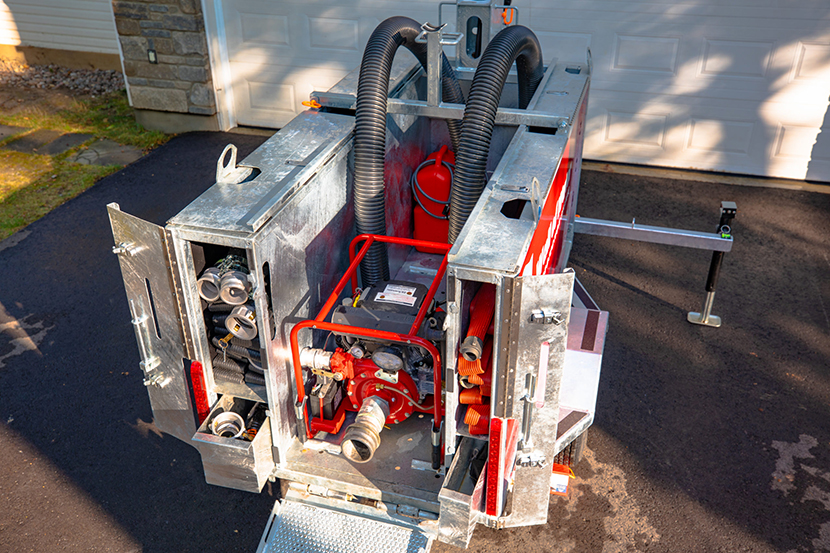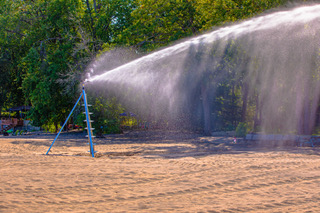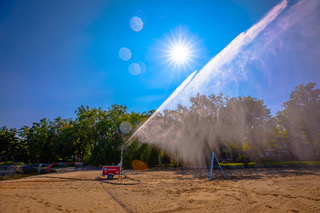Northern Miner Staff | November 4, 2024 |

The Wall of Water portable trailer contains either a 20 or 35 horsepower pump, complete with suction line, floating intake filter and supply hoses with a manual attack nozzle for extinguishing established fires. Credit: Wall of Water
An Ottawa-based company has developed a new fire prevention technology for mines and exploration camps susceptible to the increasing prevalence of forest fires. The patented fire prevention technology, described by Wall of Water (WOW) president David McKeen “as a sprinkler system on steroids,” is designed to propel a wall of water toward buildings and equipment to protect them from a raging wildfire.
“If a building in the path of a forest fire remains dry, there’s little chance of saving it from flying embers unless it’s soaking wet and that’s what my equipment does,” McKeen said.
The WOW product family consists of portable trailers that can be stored when not in use and moved into place at will; fixed mount tripods; roof mount guns; and ancillary support equipment such as self priming electric start pumps, hoses, manifolds, fittings and gun tips.

A Wall of Water fixed mount tripod can propel water 137 metres in diameter and up to 15.2 metres high. Credit: Wall of Water
Trailers, tripods and roof top units can be daisy chained and powered by pumps of up to 650 horsepower to protect the desired real estate.
McKeen describes the trailers as being equivalent to “mini fire pumper trucks.” Trailers are equipped with a pump, fuel tank, 4.3-metre-high sprayer mast, water intake/supply hoses and a gun. The sprayer will throw a wall of water up to 137 metres in diameter and up to 15.2 metres high, soaking the roof and sides of a building along with surrounding vulnerable fuel sources. Sprayer towers have a fully adjustable gun pitch angle and rotation sweep. Once deployed, the deluge of water will rotate autonomously for as long as fuel and the water supply are available.
Standard fully equipped trailers include either a 20 or 35 horsepower pump, complete with suction line, floating intake filter and supply hoses with a manual attack nozzle for extinguishing established fires. The complete system can be deployed within 15-20 minutes by two men, taken to a location by means of a pick-up truck, off road UTV, helicopter or watercraft to any remote location.

The Wall of Water fire suppression system can propel water 137 metres in diameter and up to 15.2 metres high. Credit: Wall of Water
Water can be sourced from a hydrant system, lake, river, ocean, or other water body using the suction line equipped with a floating filter that avoids intake of debris.
The pumps can be fuelled by gas, diesel or propane. To protect an unmanned exploration camp, systems can be started remotely via satellite or cellular connectivity. Fuel tanks are sized to operate for a minimum of 24 hours.
Permanent fixed mount tripods are anchored in the ground with one leg consisting of a water supply pipe and the attached water gun which is fully adjustable for pitch angle and rotation sweep.
McKeen came up with the idea while watching TV and witnessing the devastation of entire communities levelled to the ground and people losing their homes, businesses and livelihoods. “It really bothered me seeing so many people suffering from these disasters and losing absolutely everything,” he said.
A technically savvy entrepreneur with no background in firefighting, McKeen worked with Ontario fire truck manufacturer Battleshield Industries south of Ottawa to help design the initial system. Further refinements along with extensive testing continued with his current manufacturer Cadman Power Equipment in southern Ontario until performance goals were achieved and proven.
To succeed at bringing WOW to the masses, McKeen’s team has implemented a marketing strategy to introduce WOW to municipal first responders, private home and cottage owners, businesses, Indigenous communities and resorts located in forested areas.
A chance meeting with an employee from a large northern Ontario mining company at a Cottage Life trade show in Toronto introduced McKeen to the vulnerability of Canada’s mining operations, many of which are located in remote areas.
Canada’s 2023 wildfire season was the most destructive ever recorded with more than 6,000 fires torching a staggering 150,000 sq. km of forest. That’s an area larger than England and more than double the 1989 record, according to Natural Resources Canada.
Hecla Mining (NYSE: HL), Agnico Eagle Mines (TSX: AEM; NYSE: AEM), Eldorado Gold (TSX:ELD; NYSE: EGO) and Wesdome Gold Mines (TSX: WDO; US-OTC: WDOFF) were among more than a dozen Canadian mining operations that either shut down and evacuated their staff or forced the cancellation of some shifts in June 2023.
The 2024 wildfire season, according to Natural Resources Canada, consisted of more than 5,000 fires affecting more than five million 50,000 sq. km. In July, Champion Iron Mines (TSX: CIA; ASX: CIA; US-OTC: CIAFF) suspended operations at its Bloom Lake site in northeastern Quebec, and in August, SSR Mining (TSX: SSRM; NASDAQ: SSRM; ASX: SSR) evacuated its employees and shut down its Seabee gold mine 125 km northeast of La Ronge, Sask., resuming operations only in mid-October. While the mine itself wasn’t materially impacted by the fire, the company reported damage to power poles, piping and exploration equipment.
According to McKeen, WOW products have been delivered to a large remote mine in Ontario. The Ontario mine has opted to sole source several products to measure their effectiveness with a group of stationary fixed mount tripods to protect an essential building area using its own pumps and water supply infrastructure. Once the coverage area and optimum positioning of the tripods are verified, additional tripod units along with custom designed roof top sprayers will be added for further thorough encampment and work zone equipment protection.

No comments:
Post a Comment